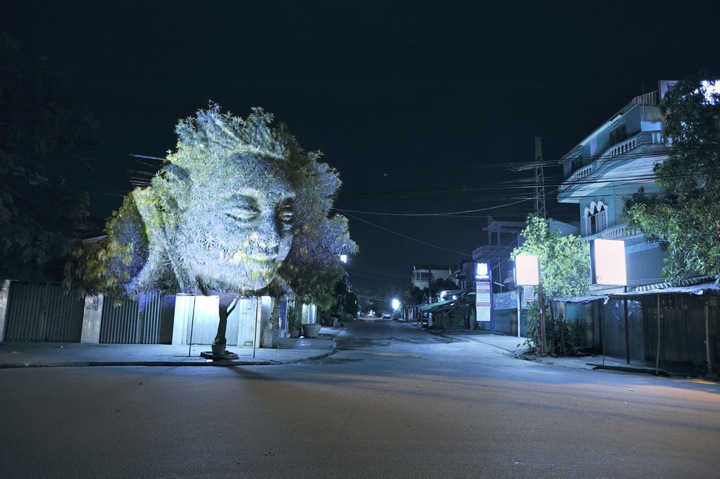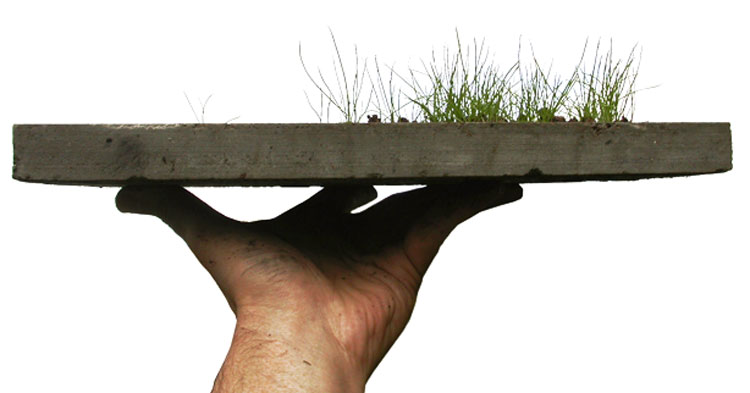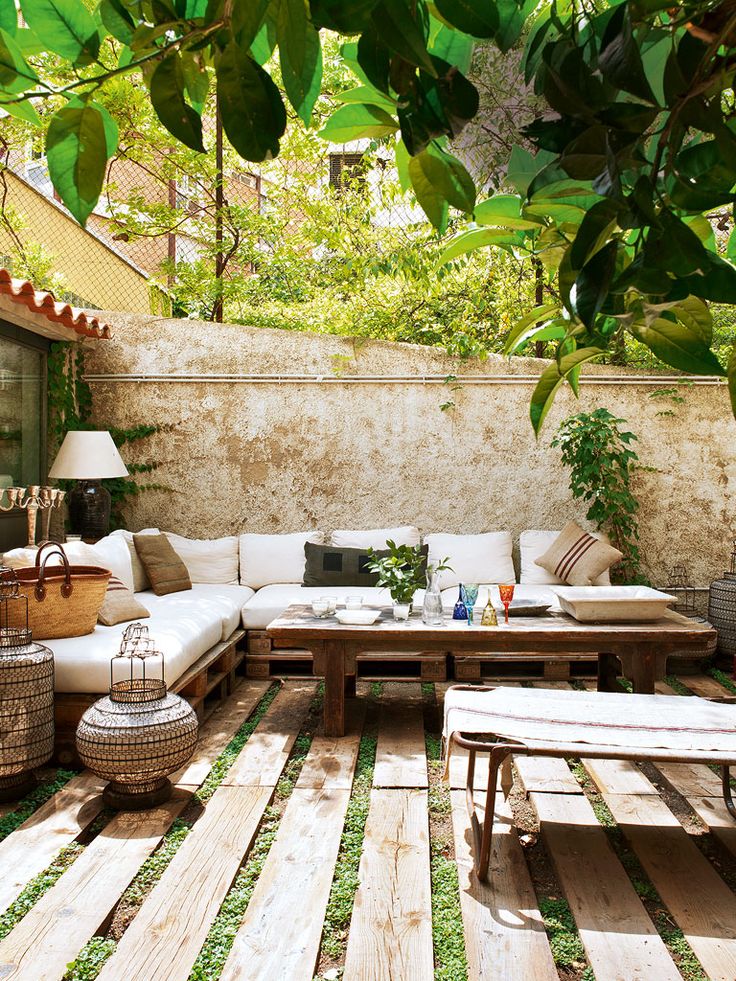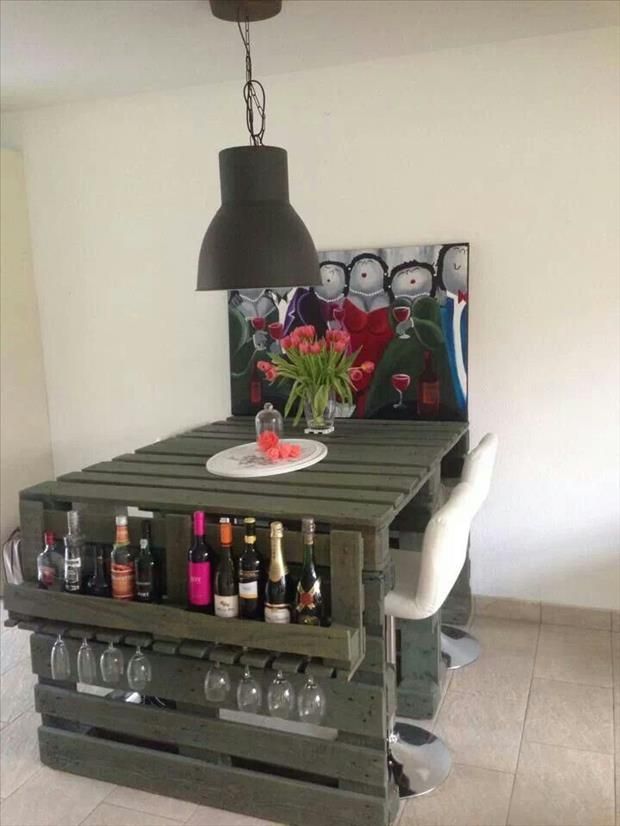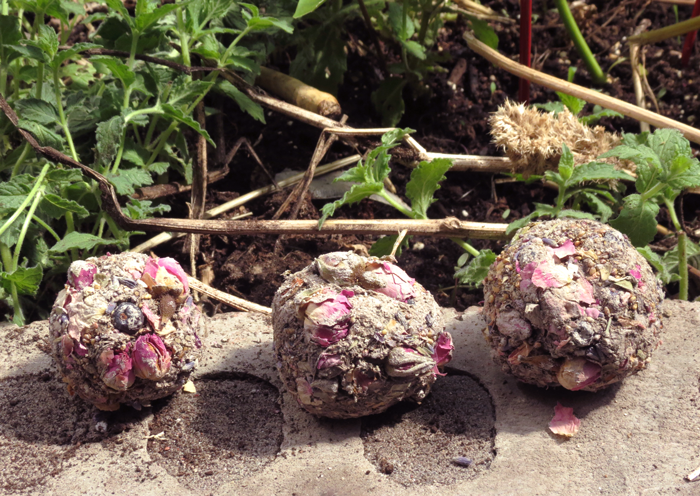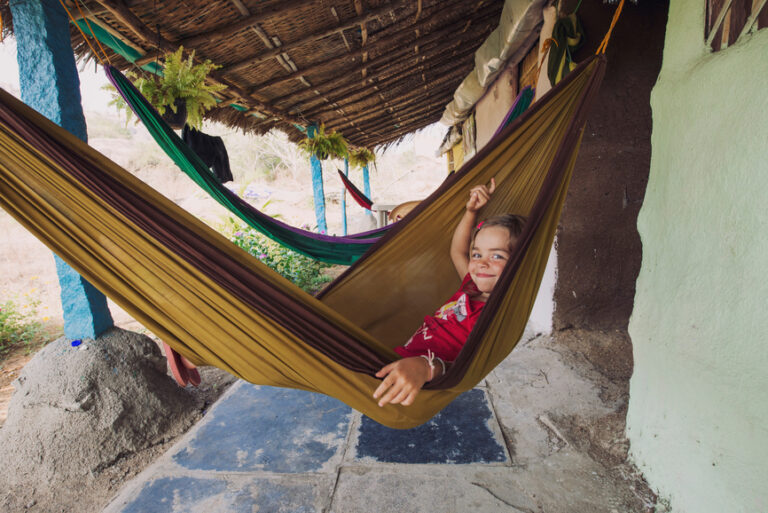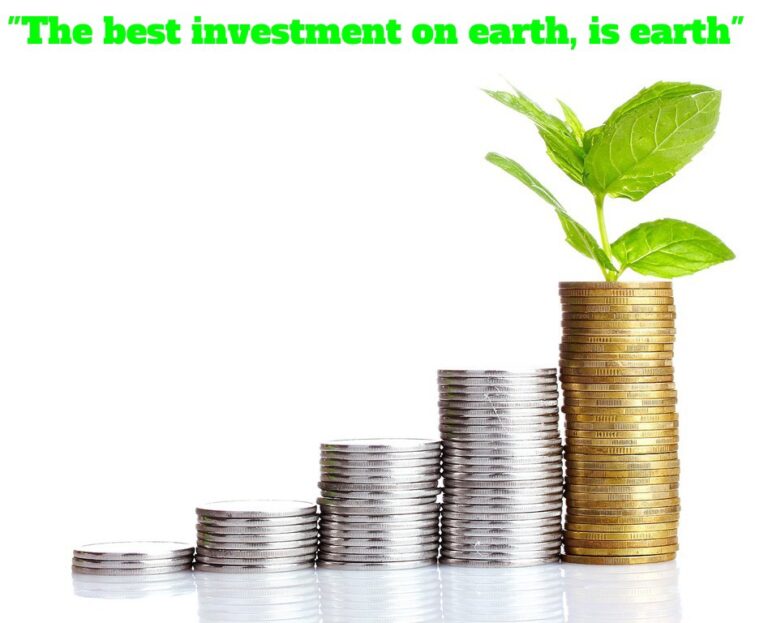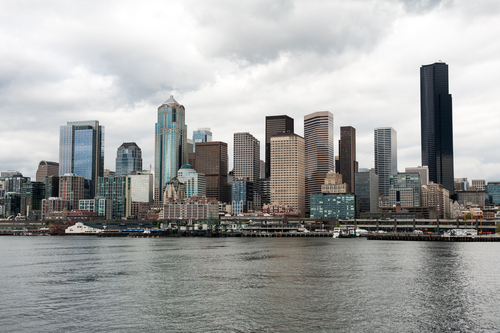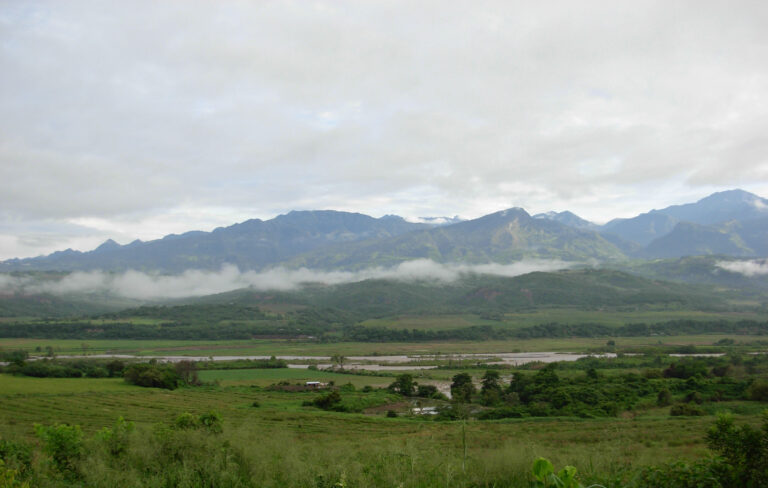Newly-Developed Concrete Absorbs CO2, Insulates & Grows Food
Researchers in Barcelona, Spain have found an innovative solution to the long-established emissions problem.
In Barcelona, Spain, researchers at Universitat Politècnica de Catalunya (UPC) have found an innovative solution to the long-established emissions problem. Science Daily reports that they discovered how to build megastructures with a biological concrete that not only lowers CO2 and regulates heat, but is pleasing to look at.
It is not only a medium for growth and a construction material, but a means to regulate temperatures indoors while removing CO2 from the atmosphere. The surface of the concrete grows mosses, lichens, fungi and other biological organisms.
The invention needs to be used in regions with a calm Mediterranean climate, but enables buildings to absorb CO2 and release oxygen with micro-algae and other “pigmented microorganisms” that coat it.
While vertical gardens certainly enhance its aesthetic appeal, one might declare that its beauty is sourced in its clever design.
The concrete works in layers: The top layer absorbs and stores rainwater and grows the microorganism underneath; it can also absorb solar radiation, which insulates the building and regulates temperatures for those who live inside. The final layer of the concrete repels water to keep the internal structure safe, shares Inhabitat.
Normal concrete has high pH levels that don’t allow plants to grow, but this newly developed one is more acidic, which lowers the pH to levels safer for growth.
The research team, led by Antonio Aguado and supported by Ignacio Segura and Sandra Manso, has big plans for the design. They share on UPC’s website:
“A further aim is that the appearance of the façades constructed with the new material should evolve over time, showing changes of colour according to the time of year.”
What are your thoughts? Comment below and share this news!
This article was written By
Do you like to read about science, technology, psychology, personal development or health? There is a new social network called Aweditoria that is purely based on interests. You can follow topics there and see the best small stories, ideas and concepts in those fields. Click here to try it out, it’s free and only takes few seconds to join. You can also follow Myscienceacademy.org on Aweditoria!
Get more content like this in your inbox!Sign up fo our free newsletter:
DYI Pallet Furniture Ideas – Easy, inexpensive & Eco Friendly
Wooden Palettes are sitting around everywhere around Montreal, waiting to be transformed. Originally they are used by businesses for big bulk shipments, but end up very often being abandoned or hanging around for months with no use or purpose at all.
This doesn’t have to be the case though, the pallets are made of good quality wood and can be reclaimed and recycled in to unique and useful projects. Pallets can be found everywhere at supermarkets, behind stores, in alleys, abandoned lots. Pretty much anywhere where there is large shipment transactions going on.
My advice to you based on my personal experience, if you want to create something with the pallets, just do it! Don’t be shy to ask the business managers or owners if you can take a few, and don’t be lazy either and make excuses that you have no way to get them. Organize for someone to help you pick the pallets up and help you deliver it to your place. If you don’t have any family or friends who are available at the time to help you, then do as I did and just put up a post on craigslist or Kijiji, in the gigs /labor section. Hire a man with a Van, it might cost a few extra bucks to help you move them but you will have something of value that you created, while at the same time being environmentally conscious and responsible.
Once you have them in your humble abode, all you need is a saw, hammer and nails, and of course your imagination! If your not too good with tools, there are many things you can create with the pallets without tools or having to take them a part.
Check out some of these interesting design ideas below. I’ve included some very simple but charming pallet furniture projects that anyone can do and some other more challenging ones for the more handy builders out there. I hope you create some beautiful creations. And don’t be afraid to push your limits, just because your not handy now, doesn’t mean that you can’t be tomorrow. Take out the drill, and use it! Don’t limit yourself by your gender either, be all that you dream of being.
We are always working on different unique Upcycling projects at Valhalla Montreal. If you would like to join in and help out with one, we are at the land every Saturday, and welcome anyone who has a calling to join in.
Wooden Pallet Coffee Table
Wooden Pallet Deck
Garden Path Made with Pallets
Wooden Pallet Bed with Storage Drawers
Wood Pallet Book/Magazine Shelf
Wooden Pallet Stair Case
Wooden Pallet Dog Bed
Wooden Pallet Outdoor Furniture
Romantic /Wedding Pallet Furniture
Kitchen Pallet Ideas
DYI Seed Bombs for wildflowers & Guerilla Gardening
I stumbled upon some alluring images the other day of colored seed bombs. I was interested in purchasing a few but they were sold out. Luckily there were no more left, because it only enforced my determination to learn more about them. I did a little research trying to find a local carrier, when it suddenly came to me why don’t I just make them myself!”
I remembered I had a bag of Wildflower seeds stacked away that I had bought not to long ago to attract hummingbirds. When I saw the ingredients called for clay, composte, water, and wildflower seeds I was really excited because I was already equipped and ready to go. There were a few different recipes to choose from, some with coloured recycled paper, but I opted for the more ancient traditional one made with clay. Since they lacked colour, I decided to just add a bit of rose petals, lavender, and calendula, elderberry seeds, and sumac in the mix to give it a subtle natural colour boost.
The plan is to Seed Bomb Valhalla this weekend! They say its best to bomb just before rainfall. Looking forward to see the mysterious flowers, that will one day miraculously bloom at Valhalla.
Ps: you might want to give people heads up that the seed bombs are not edible (hence clay & compost ) as you can see by the picture they could easily be mistaken for dessert 😉
What are Seed Bombs?
A seed bomb is a seed that has been wrapped in soil materials, usually a mixture of clay and compost, and then dried. Essentially, the seed is ‘pre-planted’ and can be sown by depositing the seed ball anywhere suitable for the species, keeping the seed safely until the proper germination window arises. Seed balls are an easy and sustainable way to cultivate plants in a way that provides a larger window of time when the sowing can occur. They also are a convenient dispersal mechanism for guerrilla gardeners and people with achy backs.
History
Seed bombs may have been used by the Ancient Egyptians to seed the receding banks of The Nile after annual floods. They have been used in Asia and elsewhere, especially in arid regions, because of their ability to keep the seeds safe until conditions are favorable for germination, and the ease at which they can be distributed.
In the Carolinas in the 1700’s, West African slaves, predominantly women, were brought in to cultivate rice using a seed ball technique that was used in Africa. Rice seeds were coated in clay, dried, and pressed into the mud flats with the heel of the foot. This served two purposes, protecting the seed from the birds, and also preventing it from floating off when the fields were flooded.
More recently, Japanese agricultural renegade, Masanobu Fukuoka, began exploring the use of seed balls (nendo dango in Japanese) to help improve food production in post WWII Japan. His research and outreach efforts has brought the seed ball back into the public eye. Today, seed balls are fun for green-minded kids and adults, and are also an important tool of the guerrilla gardening movement.
Ingredients
Air Dry Clay
Water
Compost
Wild flower Seeds ( preferably organic non gmo if possible)
*Optional: Dried Lavender, Elderberry seeds, Roses, Calendula, sumac for color.
Directions
For the dried clay mix 5 parts clay with 1 part compost and 1 part flower seeds, put some careful drops of water into the mixture (make sure not to make it into a goopy mess), Knead with hands into a ball, flatten it out and cut to desired size. Now just make into a small ball and let it dry in the sun. If you want to add color, roll the balls it to a tray of herbs.
Should you give your children ADD & ADHD Pharmaceutical Medicine?
Currently, there are somewhere between 5 and 7 million children in America diagnosed with ADD, or Attention Deficit Disorder. Some of them have been fed small doses of amphetamine since they were four or five years old.
I will be transparent with you today and reveal that I’ve suffered from ADD myself. I believe this condition comes from deeper core issues within the person. These underlying issues are important to look at in order to make an effort to resolve them.
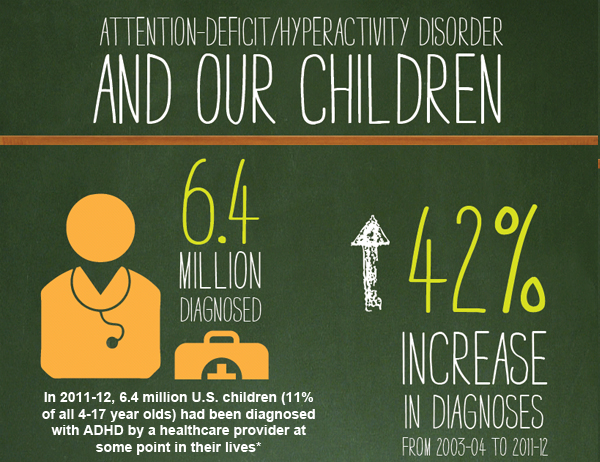
The medications on the market will certainly improve your focus and productivity. When you take the pill in the morning, it starts to kick in around an hour after. Once it takes effect, you get a stimulating boost. These boosts can feel good, yet at times overwhelming as you get a high feeling similar to recreational drugs such as Ecstasy and Speed. I am familiar with this feeling having experienced recreational drugs in my youth. The reaction is so similar that ADD medication is even sought out on the street, illegally.

I had to write this article and share this information with you because I think it’s important that parents are aware of this before deciding to put their children on these medications. I was on them for around a year when I lived in Miami. They helped me get my work done efficiently but when the “high” wears off, you crash. The crash involves feelings of isolation, coldness and a feeling of disconnection from the world. If you are self-aware, you can clearly sense that your body and spirit not responding well. This crash can continue for hours and wears off slowly. The next day comes, and you basically experience this same pattern every day that you take a pill.
It is always important to get into the habit of listening to what your body is telling you. The above symptoms are serious signs that your body isn’t approving of the medication.
For me, when it started to wear off around 5 o’clock, I would start to shiver. My house was warm, but I would freeze no matter how high the heat was cranked up. This is not the case for everyone. Everybody reacts differently to the chemicals. My coldness was a sign that my blood was not flowing properly. As soon as I stopped the medication, I no longer felt this side effect.
There’s a lot of information out there saying you shouldn’t just stop the meds suddenly. I don’t encouraging people to stop suddenly simply because I don’t know enough about this process. There are reported cases where people didn’t do well after stopping abruptly. I can only speak from my experience. Eliminating them from my life cold turkey felt great. I had no regrets and I didn’t look back.
I would rather have slightly less focus and more passion in my life than have daily crashes, anti-social tendencies and toxic chemicals damaging my body.
Having said that, it was hard for me to make the decision to stop taking the pills. I tried them again this year because my intense passion and desire to do so many things, often leads me in a million different directions. Trying to do everything at once and getting nothing done perfectly. It’s hard for me to focus for long periods, and I would get so much more accomplished when I took a pill. A task that would take me 4 hours, I could achieve in half the time.
How do I feel after cutting them out? MUCH BETTER! I’ve been managing just fine without them and it’s actually been empowering! I feel grounded and nurtured through my own true efforts and not by the quick fix of a pill.
Everyone experiences some level of stress from living in a world where we are, in many ways, enslaved by a corrupt system. There are a lot of us-even the best of us that are becoming rather zombielike.

We all need to wake up and make a change. We need to all take part in fixing these problems and take charge of creating better solutions. Solutions such as growing our own fruits, vegetables, and herbal medicines; learning to be free in our minds; as well as finding solutions to problems and acting on them. Building the lives we dream of and deserve are why we are here.
Children, teens and adolescents are part of this as they are our future. The earlier you teach them sustainable inner practices, the better you equip them for what is ahead and show them how to be meaningful participants in the world.

If I could go back and do one thing, it would be gardening daily with my daughter from the time she was a baby. This intimate connection to our earth is what will ultimately bring truer fulfillment and happiness. Healthy habits are more easily formed in the earlier stages of your child’s life.
Giving a child a pill to cure certain things runs the risk of a lifetime habit of taking pills for healing and thus avoiding facing any deeply rooted issues.
We all carry within us, wounds. Some wounds possibly from past lives, but most certainly from this present one. These deeper wounds prevent us from focusing more sharply and play a role in our self-love & compassion-or lack of it. We are all truly amazing souls, and often our untreated wounds will keep us from realizing our true potential. Both adults and children must address those deeper core issues. In doing so, we live more spirited, purposeful and healthy lives.
When we take care of ourselves and face those core issues, we can heal naturally without toxic chemicals. A much truer route to healing.

The pharmaceutical pills used to treat Attention Deficit Disorder will often just mask the core issues. It does not cure them.
I admit it is not an easy task, and it takes a lifetime of dedication.
Isn’t being true worth the effort?
You can sweep the dust under the couch, and it may look cleaner, but that dust is still there, building up with each passing day. In the back of your mind you know it’s there. At one point if you truly want a clean home, you will have to move the couch and do a big clean up.
Investigating what those deeper issues are within yourself or your child and making a commitment to rise above them, is a great beginning. Everybody’s wounded soul conflicts are unique and can change through time. Unresolved traumas can travel with us through lifetimes.
Changing diet, toxic habits that are draining you, poisonous relationships and negative thought patterns can help develop a greater acceptance and ability to surrendering gracefully to change. After all, change is a congruent part of life and rather inevitable.
Make peace with it and learn to flow with the waves. Attaching yourself to anything too tightly leads to suffering. Learn the art of letting go at each moment, each day. Be a creator and keep turning the page.

I’ve tried nearly all the varieties of ADD medicine. And they all more or less have the side effects I mentioned earlier. After my experience, I feel it’s important to share with others and warn people. I find it most alarming that children are taking them. I can’t imagine how pure little bodies are meant to tolerate such harsh chemicals or suffer from any of these serious side effects.
I’m not justifying by any means that it’s better for adults to take the pills but at least they have some life experience and can be conscious of the reactions to the medication. They are able to take a mature step back and recognize that some of the symptoms they are experiencing are not normal or healthy. Children, especially the younger ones, don’t really have this option.
Both children and adults can easily grow accustomed to the side effects and often tolerate them.
They learn to live with the crashes-desperate to keep the desired focus, productivity and stimulation. Not everyone recognizes that feelings such as depression or withdrawal are often being triggered or enhanced by the drugs. It especially goes unnoticed with children for they don’t fully understand what it is they’re experiencing.
The question that lies ahead now is, how can we treat this naturally without resorting to unhealthy chemicals?
I believe a combination of natural plant medicine, a healthy diet and commitment to caring for one’s soul can help heal on a much deeper level than pharmaceuticals. Living with purpose, truth, freedom, dreams, courage and self-love are all integral parts of healing.

Standing up for justice, world peace, our planet earth, and not supporting corrupt businesses that don’t have the peoples’ best interests at heart are also, believe it or not, connected to healing. Universally, we all face a form of illness by inhabiting a planet with corrupt leaders, large pharmaceutical industries and corporations that are running much of the show.
The system influences and enslaves us all- much more than we are willing to see and admit. Sometimes, to escape from it, you must step outside of the box.
Think about McDonalds for a moment. The food was clearly proven to be unhealthy. Why would anyone want to keeping running a business that was poisonous to people? Money. You would imagine they would choose to invest in an alternative money-maker that maybe did something good for the planet. Or completely change the menu. Sadly, this hasn’t been the case. There is enough wealth and abundance to solve world hunger and yet the struggles on planet earth seem to continue.
We can knock the big guys and point the finger all we want but who is to blame? I’d say to some degree, us! The people. These corporations and corrupt institutions exist because we support them. They exist because they have a market!
Why have we become such zombies in our culture? I won’t get in to all the different conspiracy theories of why that could be but rather suggest that people, at the very least, think carefully before you invest a dollar in anything. Think twice to be sure you want to support that cause or not.
Be the change you wish to see in the World – Ghandi

I don’t have the miracle cure to treat ADD naturally.
You don’t need to have the perfect cure. What you need is the will to explore different natural alternatives and see what works for you.
Some days may be challenging. Other days, you might feel very blessed. Such is life. But at least you honor your sacred vessel when you try. When you make that commitment to take care of your body, mind and soul, the universe brings the perfect medicines that are meant for you.
If you are a parent contemplating giving your child ADD medication, my advice to you is to try taking the meds first yourself for a week.
Yes, I know it sounds crazy, but I’m confident that once you experience the intensity of the drugs for yourself you might have serious second thoughts. It’s good to know what you’re giving to someone. I never serve food without tasting it a little myself to make sure it’s good.
Now that I’ve committed to stopping the meds and treating myself naturally, I will begin exploring…
Natural Remedies that can improve the Symptoms People Experience with ADD. Remedies given to us by Mother Nature that help treat a person as whole.
I will share these discoveries and experiences in future articles. Stay tuned! I look forward to sharing the preparations that worked for me, in hopes that they work and help others too. Also coming up in future posts, my experience with Cannabis oil for Healing. The good and the bad.
If you are living in the Montreal area and looking for natural healing help from a professional holistic practitioner for yourself or a child, please feel free to be in touch or consult the Natural Healing section of the Back to Eden Healthy Living Directory
By: Shoshana Finn
Investing in the earth vs investing in a bank, which is more rewarding?
Today I was thinking about how I come across a lot of people who see the spiritual or (at the least) the nutritional value in gardening, but for some reason think it’s not financially rewarding and use that as an excuse to opt out of even trying. When I tell people that I see immense value in growing a food garden each year some of them say things like “I don’t have time for playing in the mud, gardening doesn’t pay the bills!” But is that really true?
According to the government the average Canadian household spent $8109.00 on groceries in 2014 ( a very conservative amount in my estimation). And how much of that food do you think is processed, contains GMOs, or is chemical laden leading to a shorter and less full life, with big medical expenses down the road. Spend $20-40 on basic supplies and with only a weekend or two spent preparing the soil in the garden or (growing containers for your balcony, windows etc) each year, and a quick watering before work each morning Will result in a significant amount of veggies (hundreds of dollars worth of fresh organic produce). Truthfully, anyone can do this to some extent, and in doing so feel good knowing they are doing their best to feed their family real- healthy- nutritious food.
In my previous post I talked about “investing in the earth” vs investing in a bank, and spoke about the value to one’s spirit, body and to the future generations. I want to now address the potential material rewards of investing one’s money and time into the earth, vs investing that money and time into a bank.
While sorting and packaging the heirloom kale seeds I had saved from last year’s garden it occurred to me that not only is investing in the earth more nutritionally, spiritually, and emotionally rewarding than investing in a bank, it can be more fiscally rewarding as well. The fact is when you invest in a garden you end up with an abundance of not only crops with more than enough to share with friends/neighbours but also the abundance of seeds that can be saved from each harvest. I began to contemplate what the latent money value of these seeds were (if they were all to be grown and harvested from a garden), and then proceeded to compare my original investment in the package of organic kale seeds (less than $5 ) which I “deposited” into the earth to what kind of return I would have gotten had I invested that five dollars into a bank. Here’s what I came up with:
Investment of less than five dollars on kale seeds (about 20 heirloom “red russian” seeds) result/return after one year : ten healthy adult kale plants which I harvested semi-daily from June until November ( We ate about ten dollars worth of kale at local store prices a week from the garden, so after 6 months they produced about 240 dollars worth of organic kale). So from less than a five dollar investment (along with time spent every few days on watering and tlc) I got $235.00 return from investing in the earth (a 4800% increase)! Now how much return would I have gotten if I invested 5 dollars in a bank after one year? Well let’s say the savings account has an interest rate of 3% (which is being generous for most banks) after one year from my original 5 dollar investment I would have a whopping 15 cents return!
After that first year of investing in the earth by “depositing” the kale seeds and letting the plants go to flower (on top of my steady harvesting) I was able to save well over a hundred seeds from each plant at the end of the year (which will amount to over one thousand viable seeds achieving maturity/full harvest). Since with gardening (“investing in the earth”) there is always abundance and more than enough to go around, I will share many seeds with friends, family and neighbours. I then decided I wanted to project this investment comparison further in compounding it over multiple years. I will give about ten seeds to each person/family and all I will ask in return is that they save seeds from their kale plants and share them with others. I wondered how much actual money value in kale could be grown, harvested and enjoyed after seven years of this “pay it forward model” of gardening kale, saving seeds and sharing the next year. In the interest of making a fair calculation I wanted to be very modest with my estimates for projected harvest yields and seeds able to be saved each year (considering not all plants will grow in great soil under ideal conditions). So I estimated that for others each ten kale plants would yield a minimum of 10 pounds of kale annually (amounting to 30 dollars worth of organic kale at $3.00 a pound). And instead of assuming they will be able to save 1000 seeds like I did, I estimate they will save well over one hundred (amounting to one hundred viable seeds that grow into harvestable mature plants.
So let’s recap; with my 1000 seeds (from my first harvest) being given to 100 families/gardeners, after the second year a total of $3000.00 worth of organic kale would have been grown, harvested and enjoyed by those people (“collective beneficiaries” of my investment in the earth). That means, from my original money spent (less than 5 dollars) invested in a pack of seeds, some water and tlc, and sharing the resulting seeds after only two years a return of $2995.00 would be collectively accessed and enjoyed. While that same five dollars invested in a bank would have earned me you guessed it! A colossal 30 cents! :)
With an original investment of five dollars After seven years continuing this ‘pay it forward model’ investing in the earth compared to investing in a bank you would have this:
Bank total (money value accessible by one): $6.17
Earth total (latent collective money value) : $30,000,000.00
When we choose to give back to the living planet that sustains us and share the resulting abundance, the rewards increase exponentially and continue to give back year after year.
Let’s invest in a future where food, health, and happiness are abundant and common place. We can make the choice to truly care for our body and in the process give back to the earth that gives so much to us. Each of us can do this by planting and maintaining an organic food garden of our own. Thank you to those who care enough about the earth to do this without any hope for financial reward, but for those of you who need to measure the reward in dollar signs, the numbers don’t lie, choosing a bank over the earth is clearly a poor investment choice.
The Bees that Make Honey with Cannabis Resin

He is an artisan, locksmith and above all a beekeeper, although he does not carry out the last profession like others. His more than 4300 Facebook followers and 700 Instagram followers are looking for something that nobody else can offer: marvellous photos where cannabis plants receive an agreeable visit. Although most of us would be scared to find bees on our crop, that is the main goal of this 39-year-old Frenchman who describes himself as an advocate of medical cannabis and of legalisation.
He is called Nicolas, although he is known as Nicolas Trainerbees, a nickname that is not a mere coincidence. He has been using it for more than 20 years because he has always liked to spend time with all kinds of animals, especially insects, and above all, bees. He observes them, and according to him (although without revealing his tactics), he trains them so that they behave as he wishes.
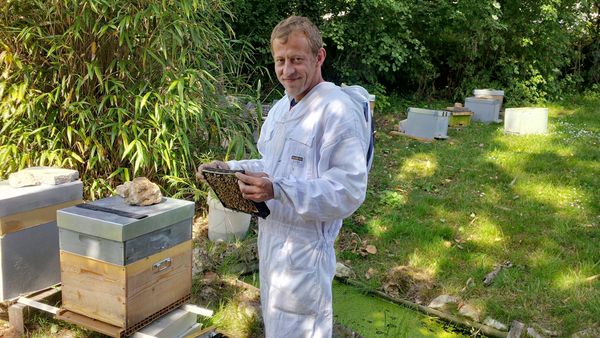
“I have trained bees to do several things, such as collect sugar from fruits, instead of using flowers”. In addition to beers, he has also worked with tarantulas, lizards and ants because, as he explains, he has “been passionate about nature since childhood”. This has led him to learn about the world of animal biology, entomology, cannabis growing, improving all kinds of plants and everything related to the world of beehives.
For a while now he has been working with bees that produce “cannahoney”, the name he decided to give to his peculiar cannabis honey. However, he modestly says that he has not created honey, “but rather a training technique whereby the bees collect the resin and use it in the beehive”. Afterwards, the final substance is the sole work of the little insects.
How did a beekeeper decide that his bees should obtain nectar from cannabis? Firstly, due to personal experience. Nicolas has been hyperactive since the age of 7, and that along with an educational system that labelled him as “unsuitable”, soon led him to leave school. At a young age he discovered that the plant helped him to channel the problem and, therefore, “I began consuming before the age of 10”, he states.
Years later, many people that know about his abilities raising and training bees began to ask him why he would not start applying them to the world of cannabis, and get the insects to create a kind of honey with the cannabis plants. He had realised that, by uniting the properties of both things, and if the animals managed to use the resin correctly, he would obtain a great result: “For some time I had known about the health benefits of bee products such as honey, propolis, pollen, wax and royal jelly and also about the benefits of cannabis”, and so he decided to take notice of the requests.
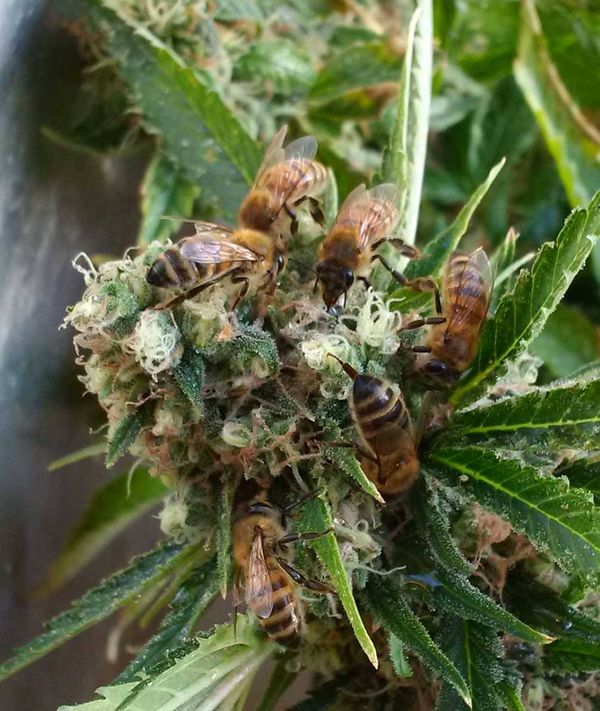
Also, “everything that passes through the body of a bee is improved”, he says, given that their enzymes make the nectar turn into the desired honey. The resin obtained from willows, poplars and other trees is turned into propolis, which is an antiseptic, antibiotic, antifungal, antibacterial and also has healing properties. “So if the bee took the resin from cannabis it would also be very beneficial”. “The aim arose for me to get the bees to obtain this resin “, he comments.
From that moment onwards (back in 2006) he spent time observing them, examining the hives and the behaviour of their members and thinking that there had to be a way of attracting a good group of insects to the resin. “That was the starting point for my investigation”, he explains. When he began his inquiries he found that up until then nobody had brought together both worlds, and the most sceptical people even told him that cannabis was not a typical plant for obtaining honey, therefore it would be impossible to get the bees to go by themselves to collect its particular pollen. Nicolas has shown the most simple-minded people that they were wrong.
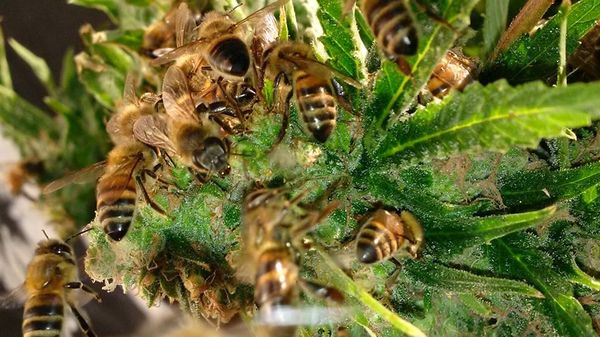
Following several tests and lots of observation he managed to get results from his training in 2013, “with the enormous surprise that the bees used the resin as propolis” and also to create honey with the same effects as cannabis. Its terpenes have “a delicious and pleasant taste” that are reminiscent of the fresh plant, although its taste changes slightly from one crop to another.
“Cannahoney” normally has “quite a floral” aroma and a colour that slightly changes depending on the varieties, although it usually ranges from light green to white or yellow. The substance “is not smoked, it is ingested and it is good for health”, explains the creator.
Nicolas uses varieties of cannabis that he has created. He says that, “the bees accept any strain”, therefore he also uses already existing types. In fact, the last batch of honey was created using Californian Orange.
Before he obtained his first results, some people dared to say that cannabis was harmful for bees. He was totally convinced that was not the case, but he had to wait two years until the project was well consolidated and he was able to demonstrate that the plants had no negative impact on the insects. “The bees that produce the cannahoney are not affected by cannabinoids because they do not have an endocannabinoid system”, he explains.
He now has 30 beehives, and he uses many of them for his cannabis honey project. However, he faces difficulties living in a country that puts up a lot of barriers in relation to all cannabis matters, therefore he is forced to grow his plants in open air spaces, far from his home. In this situation he takes a lot of risks, especially trying to transport his plants close to the hives during the necessary time so that the bees can take advantage of their new “pollen”.
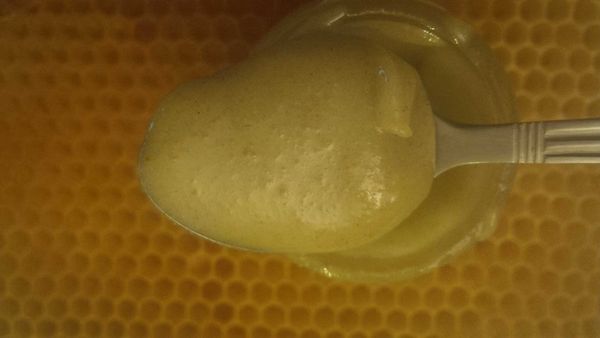
His situation does not prevent him interacting with his followers over social networks, where he normally publishes lots of research studies that back the medical properties of cannabis that he himself experiments with. The photographs that he publishes speak for themselves; in them it is possible to see not only the plants accompanied by the bees, but also, for example, crepes created by him and served with his honey. Nicolas dedicates almost all of his time to this profession; therefore he has no website or blogs: “I work alone with my wife and I do not have time or money to do much else”.
Such attractive photos ensure that many users ask him endlessly when they will be able to get hold of the substance, although he admits that he still requires a more detailed analysis in order to determine all of its properties. Despite this, he states that three people with anxiety tried a few spoonfuls “and felt a lot better”.
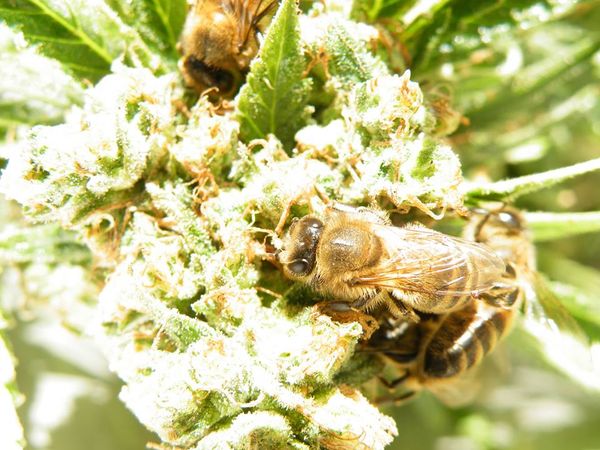
His progress is now an example to follow for many other beekeepers. Now, his main aim is to leave France in order to treat his illness legally and also to work with more freedom and get professionals in the sector to analyse his work. His next destination, if everything goes as he hopes, will be Spain.
——–
Latest Promotion! Don’t miss out…
The Importance of Conquering Your Fears
For many of us fear is something we deal with on a day-to-day basis, whether it’s a huge, impending threat (like death or tax time), or something relatively small. While fear itself is not necessarily a bad thing (in fact it is an important survival mechanism), the cumulative effects and repercussions can be enormous, and extremely destructive to ourselves and those around us. With this in mind, learning to control and conquer our fears is an essential skill, we should all have, in order to lead richer, fuller lives.
For that reason, we’ve crafted a quick and easy challenge to help you identify, and overcome all your fears like a true Super hero. Take the challenge here!
Before we can really conquer our fears though, we need to know what we’re dealing with. Fear is a feeling of distress that arises from a sense of an impending threat. What’s really interesting about this, is that the threat needn’t necessarily be a real, tangible danger. Indeed an indirect or imagined threat is often much more powerful and debilitating. A prime example of this phenomenon is in horror movies, where the suspense and the looming sense of danger is often much more terrifying than the confrontation itself. Real or imagined though, the phenomenon is in fact an important evolutionary survival mechanism, which serves to protect us from harm. In the presence of fear, our adrenal glands kick into overdrive, flooding our system with adrenaline, stimulating our blood and oxygen flow, which heightens our physical functions of strength and speed, and dilates our pupils, enhancing our ability to see, detect and therefore avoid danger. While this  is without doubt an amazing and remarkable function, it is not without it’s drawbacks.
is without doubt an amazing and remarkable function, it is not without it’s drawbacks.
In the modern world we live in, where mankind has taken dominion over most of the planet, this acute system of ours, honed over millennia, is no longer as imperative to our survival as it once was, and adverse effects are a natural by-product when not dealt with appropriately.
Today the vast majority of the fear we experience is of a non-physical nature; fear of failure, humiliation, public speaking, etc, and without a direct threat to respond to, or an appropriate outlet, this fear and the physiological effects it brings, result in impaired mental capacity, and reduced logical and rational information processing. When therefore, fear begins to drive our thoughts and actions, our reactionary ability is compromised and we often find ourselves scrambling to protect our illusions of security and safety, thereby inhibiting ourselves from ever really learning from the experience, growing as people and blocking our ability to reach a place of courage, joy, peace or acceptance.
The implications of fear left unchecked are far reaching and incredibly damaging. Because fear is to us a position of vulnerability, our tendency is to turn this fear into anger – a much more powerful and less vulnerable emotion.
Given that our minds are the Captains of our vessels and the interactions we have with the world, the presence of fear can be a poisonous influence.
Physiologically speaking, it threatens to weaken our immune system, cause cardiovascular damage, gastrointestinal problems (ulcers, irritable bowel syndrome, decreased fertility, etc), impair brain functions (particularly causing damage to the hippocampus), and our ability to regulate emotion; making us more susceptible to react to future stimuli with fear or anger and ultimately can lead to clinical depression, accelerated ageing, and even premature death.
It’s clear then how damaging the influence of fear can be, therefore it’s all the more important to realise that you can never truly run from your fear. You can keep on running, but sooner or later, you will find yourself backed into a corner. Therefore, one of the most valuable skills for both our mental and physical health that we can teach ourselves and others is how to control, and conquer our fears.
The truth is, there is no “easy way”, or side-stepping this process; the way to conquering fear is to tackle them head on, not to run around t hem. Start small and progressively shatter your limits. With each little victory, you will gain the courage to tackle the next, and will find yourself empowered in the process.
hem. Start small and progressively shatter your limits. With each little victory, you will gain the courage to tackle the next, and will find yourself empowered in the process.
The truly courageous are not those without fear, but those who stand up and face that fear head on. In doing so, they unlock perhaps the greatest super power that we as a species can wield; by harnessing the adrenaline fuelled, hyper-sensitivity of their fear – all senses functioning at optimal capacity, and clear-headed focus and mental acumen. It’s a phenomenon well known to adventure sports athletes, simply referred to as “the zone”. More importantly though, by squaring up to your fears, and tackling them face to face, you “flex the muscle” of courage, gain a new sense of freedom, inner confidence, and faith in your own power and potential.
With this in mind, we’ve created a five step process to help you master your fear, and push your own limits, through much trial and error. Check it out.
Identify your fear
Make sure you’ve identified the true root cause – the dirty, brutal, uncomfortable truth; acknowledge and accept it. By doing so, it will begin to lose it’s power. Mental game is half the battle.
Visualise
Visualise yourself overcoming that fear in a real-time scenario, make it as vivid as possible in the details as possible. Break it down step by step. Repeat regularly and it will start to feel normal, or at least more comfortable.
Breathe
Quick, shallow breathing is often a catalyst of anxiety, and other symptoms often follow. If you can control your breathing, you can keep your mind focused and in control.
Breathe in through your nose, and out through the mouth. Exhale for roughly twice the amount of time as the inhale. This is a proven method to lower your heart rate.
Accountability
Find someone to join you in the journey and help you along the way. Having someone beside you takes the onus off just your own shoulders, and provides the extra push to get it done. This is universally applicable, whether you want to hit the gym more, conquer fears, or anything that takes some pattern-forming.
Action
It’s time – you’re ready. Stay focused, stay calm and go. You’ve got this!!
To wrap this up, remember, fear in itself is just an elegant survival mechanism that we ourselves can master. By conquering your fears and pushing your own limits, you will empower yourself for a richer life.
If you’re struggling to overcome your fears, or you could use another hand, check out the Dream of Flight Challenge! for that extra little push, and to help you on the way!!
Dirt is Better Antidepressant Than Prozac
There’s no denying that standing in the garden and picking your first summer tomato gives you a good feeling. Even in an urban environment a small pot of basil on the windowsill can brighten your day. But is there a scientific reason that getting our hands dirty makes us feel good?
In 2007, Christopher Lowry, associate professor in the Department of Integrative Physiology and Center for Neuroscience at Universtiy of Colorado Boulder, and a team of researchers published an article in Neuroscience that had people wondering if dirt was the new Prozac. The study examined a specific soil bacterium, Mycobacterium vaccae, and its potential role in the regulation of emotional behavior. In other words: did the bacteria have antidepressant qualities?
“Soil, especially soil with abundant organic matter, contains saprophytic bacteria, meaning that they live off of dead and decaying organic matter, such as leaves,” says Lowry. “Humans coevolved with these bacteria over millennia and they have been shown to affect the immune system in a way that suppresses inflammation. This means that these bacteria may be helpful in preventing or treating diseases with excess inflammation.”
So what exactly are diseases with “inflammation?”
“This includes conditions like asthma, but also, perhaps, stress-related psychiatric disorders characterized by elevated inflammation, such as major depressive disorder or post-traumatic stress disorder,” says Lowry.
It’s not so surprising that we may benefit from microorganisms in the soil, given that we need them to live.
The regulation of the immune system is indeed connected to the biodiversity of the natural environment. We benefit from being outdoors and exposed to things like soil and animals, because of the fact that we’re exposed to microorganisms.
“A human is not an individual. We are ecosystems. At least 90% of the cells in a human body are microbes, most of them living in the gut,” says Graham Rook, professor at the Centre for Clinical Microbiology at the University College London. ” These organisms constitute the ‘microbiota,’ and the microbiota should be regarded as an organ, just like your liver or your brain.”
While the organisms that make up that microbiota are inherited – like we inherit genes – there is a proportion of the organisms that come from elsewhere, and that’s where things get interesting.
“An unknown proportion of the organisms that constitute the microbiota come from the environment,” says Rock. “It now seems that the most likely explanation for the health benefits of exposure to farms, dogs in the home, and green space is that the natural environment (including the animals in it) is a resource that provides organisms as we need them.”
Just last year Rook published an article that explored those connections, concluding that the regulation of the immune system is indeed connected to the biodiversity of the natural environment. We benefit from being outdoors and exposed to things like soil and animals, because of the fact that we’re exposed to microorganisms.
The psychological benefit of nature has been well documented. When it comes to being happy or not, many studies show that psychiatric problems are more common in urban than in rural communities. That makes Lowry’s and Rook’s research interesting, as it gives us a better understanding of exactly why being outside, in a garden or on a farm, makes us feel good.
“People usually assume that the health benefits of exposure to green space are due to exercise. In fact two large studies now demonstrate that although exercise is definitely good for you, it does not explain the beneficial effect of green space,” says Rook. “Contact with microbial biodiversity is looking like the most probable explanation for the green space effect.”
So if microorganisms are good for you, how much exposure do you need to have in order to reap the benefits? How many days in the garden do you need to commit to?
That’s what’s still unclear.
“We don’t yet know how much exposure to environmental bacteria (for example, through activities that involve contact with the soil) is enough to confer health benefits,” says Lowry. “It is clear, however, that exposure through breathing or consuming specific types of environmental organisms has the capacity to reduce inflammation and confer health benefits.”
Which means that you now have another reason to go outside and get your hands dirty.
Seattle. Sixth City to Sue Monsanto Over PCB Contamination
The city of Seattle is suing agrochemical giant Monsanto over the contamination of the Lower Duwamish and city drainage pipes with polychlorinated biphenyls (PCBs).
The complaint, filed Monday in federal court, alleges that Monsanto knew how toxic PCBs were to humans and the environment, but continued to produce and sell the chemicals for decades anyway. Seattle is now the sixth city to sue Monsanto over PCB contamination, following San Jose, Berkeley, Oakland, San Diego, and Spokane.
“Long after the dangers of PCBs were widely known, Monsanto continued its practice of protecting its business interests at our expense,” City Attorney Pete Holmes said in a statement. “The City intends to hold Monsanto accountable for the damage its product wreaked on our environment.”
The Lower Duwamish is now considered a federal Superfund site, ranking as one of the most toxic waterways in the United States. The EPA estimates that the full cleanup of the waterway will cost $342 million.
According to the city, PCBs have been detected in 82 percent of drainage pipe samples and 73 percent of street right-of-way catchment basin samples in Lower Duwamish drainage basins. PCB exposure has been linked to several different different types of cancers, as well as endocrine, reproductive, immune system, and nervous system issues. Exposure is wide-ranging; PCBs have been found in everything from fish to human breast milk.
I’ll be heading to a 10:30 press conference at City Attorney Pete Holmes’ office to learn more. In the meantime, read the complaint here.
100 Amazonian Communities Construct Government To Protect Their Lands
The Wampis people of Peru recently created the nation’s first Autonomous Indigenous Government, which does not seek independence from Peru but intends to protect their rights and their territory.
On November 29, in the town of Soledad, the Wampis announced the formation of their autonomous government that brings together 100 Wampis communities, representing over 10,000 people that reside in the northern Amazonian part of Peru which extends across 3.2 million acres (roughly the size of the U.S. state of Connecticut).
The process that lead to the formation of the new government took place over several years, with over 50 community meetings and 15 general assemblies according to Wampis officials. They were inspired to create the new government by the United Nations Declaration on the Rights of Indigenous Peoples as well as Peruvian laws that acknowledged indigenous rights.
The motivation for the new government also grew out of frustration with how Wampis territory was being sold or given away, without their consent, to various businesses.
One of the Wampis leaders, Andres Noningo Sesen, explained some of their goals in a press statement released in December.
“We will still be Peruvian citizens but now we will have our own government responsible for our own territory. This will allow us to defend our forests from the threats of logging, mining, oil and gas and mega dams. As every year goes by these threats grow bigger,”
-Andres Noningo Sesen, Wampis Leader
One of the defense related examples given by Wampi leaders is their sustained resistance to gold mining operations in their territory by the Afrodita, S.A. Company which was finally ordered to suspend operations along the Cenpea and Maraño rivers. Both rivers suffered from severe mercury and cyanide stemming from mining activities in the area and indigenous resistance to the pollution is credited with forcing the suspension.
“This unity will bring us the political strength we need to explain our vision to the world and to the governments and companies who only see the gold and oil in our rivers and forests. For them, too often we are like a small insect who they want to squash. Any activity planned in our territory that will affect us will now have to be decided by our own government which represents all our communities,”
-Andres Noningo Sesen, Wampis Leader
The Wampis communities started the process towards autonomy by passing a statute known as the Statute of the Autonomous Territorial Government of the Wampis Nation, in which they outlined their plans for the future including protection of religion, spirituality, education, language and the recovery of ancestral place names.
While Peruvian officials have not publicly acknowledged or commented on the formation of the Wampis Autonomous Indigenous Government, Wray Perez Ramirez, the new President of the Autonomous Territorial Government has expressed confidence in their effort.
“We trust that the Peruvian State will support our initiative. This will assist in the compliance of their obligations to respect the fundamental rights of the Indigenous Peoples to determine their own future,” Ramirez said.
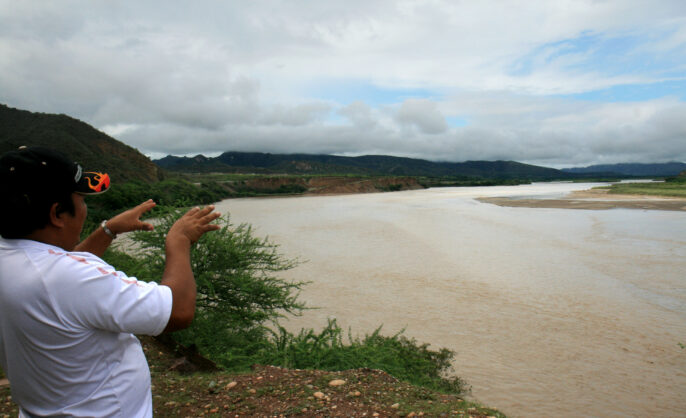
![]()



